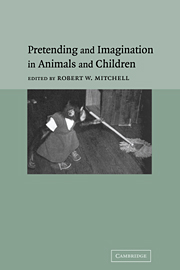Book contents
- Frontmatter
- Contents
- List of contributors
- Foreword by Sue Taylor Parker
- Preface and acknowledgments
- I Historical, developmental, and comparative overviews
- II Pretense and imagination in children
- 4 Language in pretense during the second year: what it can tell us about “pretending” in pretense and the “know-how” about the mind
- 5 A longitudinal and cross-sectional study of the emergence of the symbolic function in children between 15 and 19 months of age: pretend play, object permanence understanding, and self-recognition
- 6 Caregiver-child social pretend play: what transpires?
- 7 Just through the looking glass: children's understanding of pretense
- 8 Young children's understanding of pretense and other fictional mental states
- 9 Pretend play, metarepresentation and theory of mind
- 10 Replica toys, stories, and a functional theory of mind
- 11 Young children's animal-role pretend
- 12 Imaginary companions and elaborate fantasy in childhood: discontinuity with nonhuman animals
- III Pretense and imagination in primates
- IV Prospects
- References
- Author Index
- Subject Index
10 - Replica toys, stories, and a functional theory of mind
Published online by Cambridge University Press: 13 August 2009
- Frontmatter
- Contents
- List of contributors
- Foreword by Sue Taylor Parker
- Preface and acknowledgments
- I Historical, developmental, and comparative overviews
- II Pretense and imagination in children
- 4 Language in pretense during the second year: what it can tell us about “pretending” in pretense and the “know-how” about the mind
- 5 A longitudinal and cross-sectional study of the emergence of the symbolic function in children between 15 and 19 months of age: pretend play, object permanence understanding, and self-recognition
- 6 Caregiver-child social pretend play: what transpires?
- 7 Just through the looking glass: children's understanding of pretense
- 8 Young children's understanding of pretense and other fictional mental states
- 9 Pretend play, metarepresentation and theory of mind
- 10 Replica toys, stories, and a functional theory of mind
- 11 Young children's animal-role pretend
- 12 Imaginary companions and elaborate fantasy in childhood: discontinuity with nonhuman animals
- III Pretense and imagination in primates
- IV Prospects
- References
- Author Index
- Subject Index
Summary
From the Barbies and Batmobiles of the primary school to the cuddly pups and bulldozers of the preschool, an impressive amount of pretend play happens with objects designed to be used in pretense. On one day, the rage is for Cabbage Patch dolls and Ninja Turtles and on another Beanie Babies and Nano fighters. Some modern toys are promotional and come with an adult-authored story line. Others represent generic characters (babies or pets) or real creatures from field, zoo, or farm.
Representational toys have been found in archeological digs, pyramids, and ancient graves (King, 1979). They have found their way into museums recording the development of playthings throughout the ages. Dolls were once made of corn husks or banyan leaves; toy canoes were scooped from fallen tree limbs; horses and tigers were fashioned from mud or carved from stone. Human culture has endowed these representational objects with immense significance as though these artifacts of childhood hold clues to the beginnings of human thinking, expression, and feeling. As early as the second year of life children spontaneously talk to and for these inanimate representations of real or imagined creatures; children make these objects act upon things and with one another. From an early age, human children gleefully attribute life, feeling, and thinking to inanimate things.
- Type
- Chapter
- Information
- Pretending and Imagination in Animals and Children , pp. 142 - 153Publisher: Cambridge University PressPrint publication year: 2002
- 2
- Cited by



